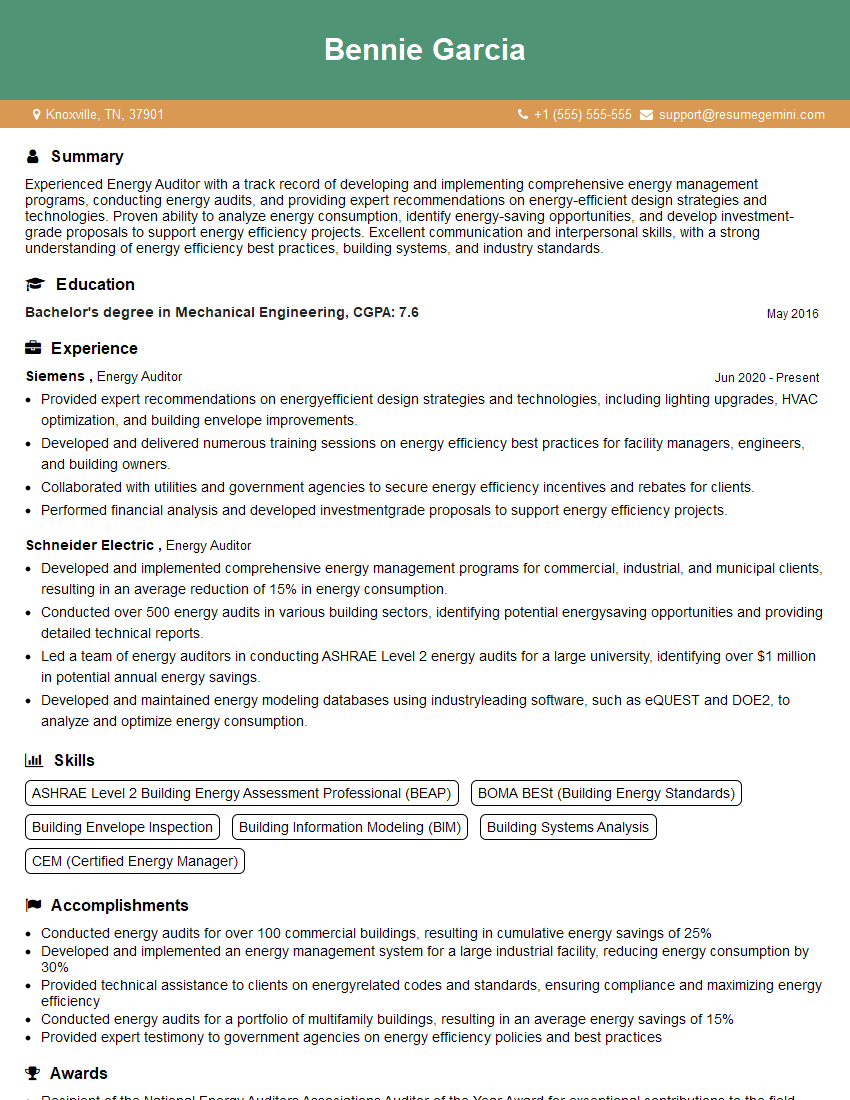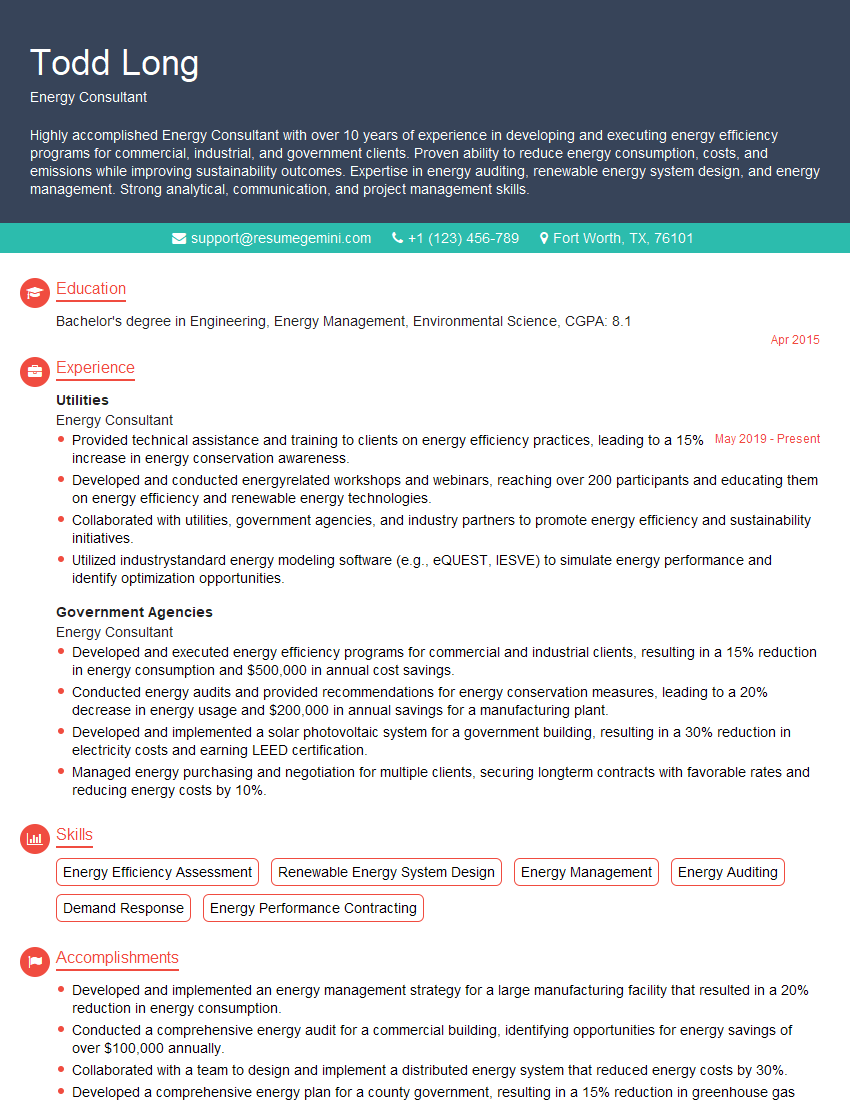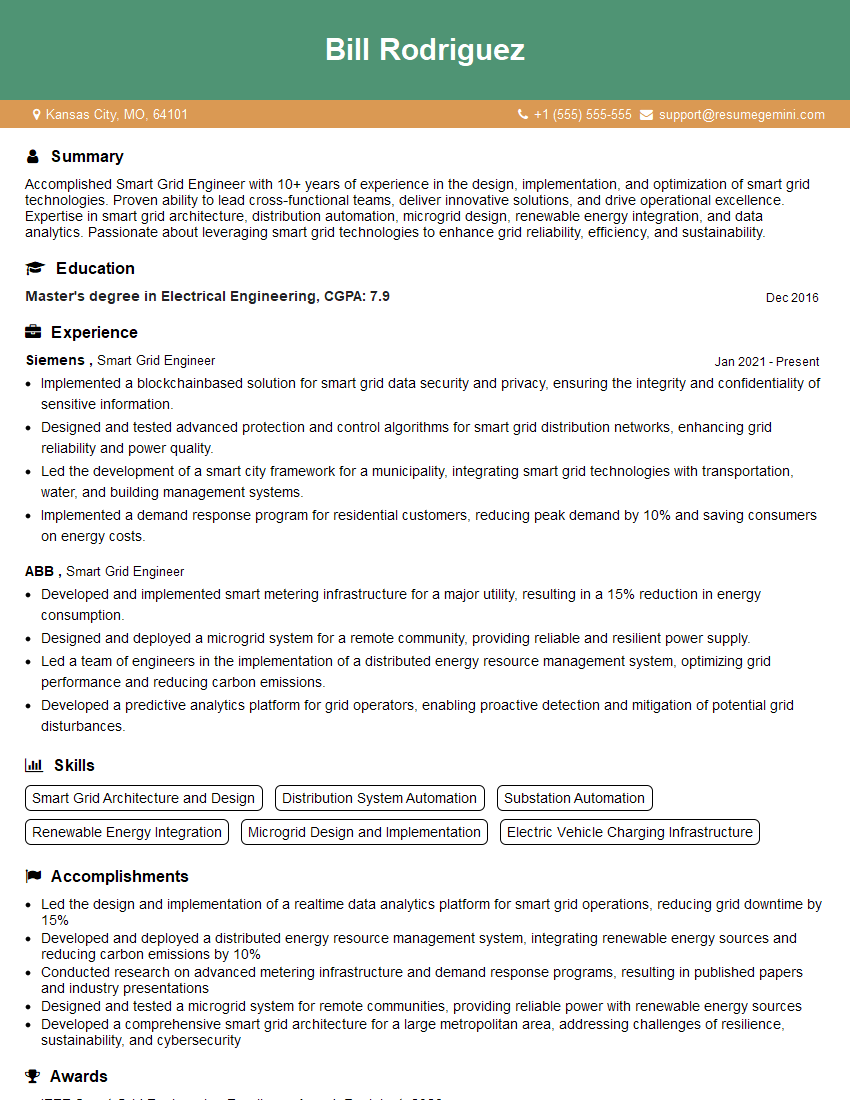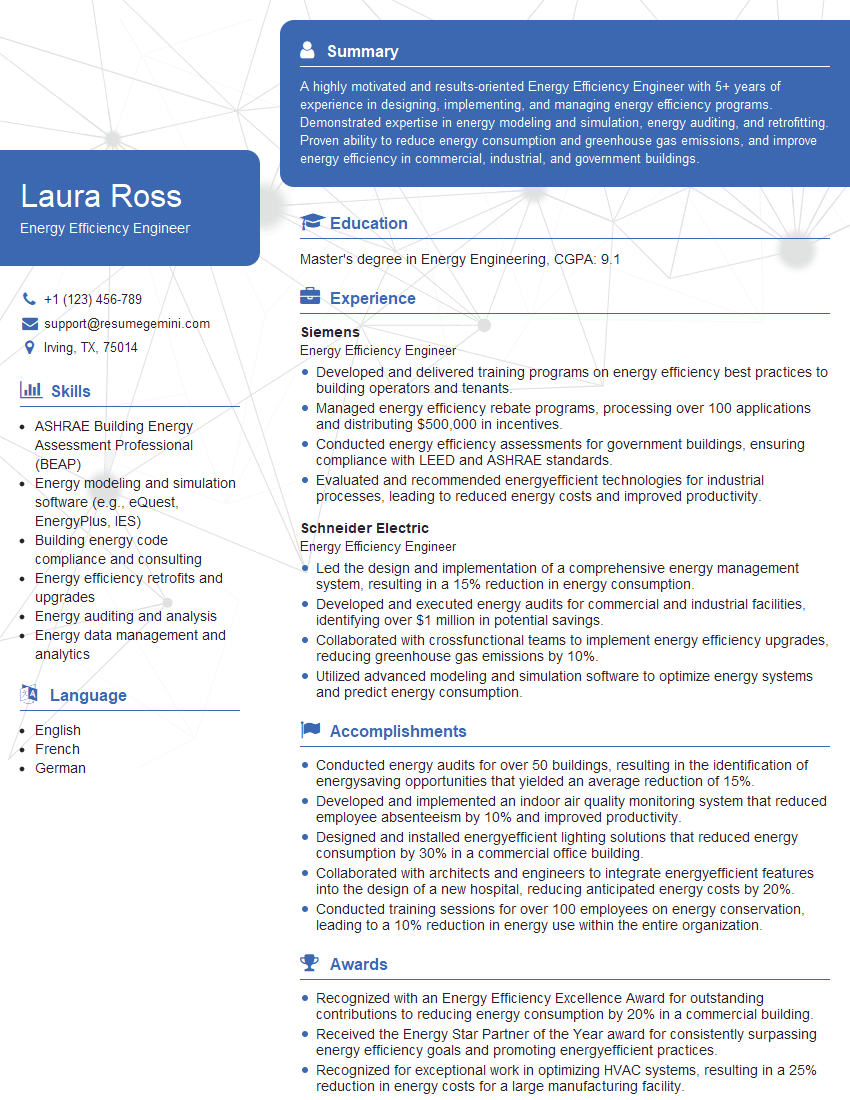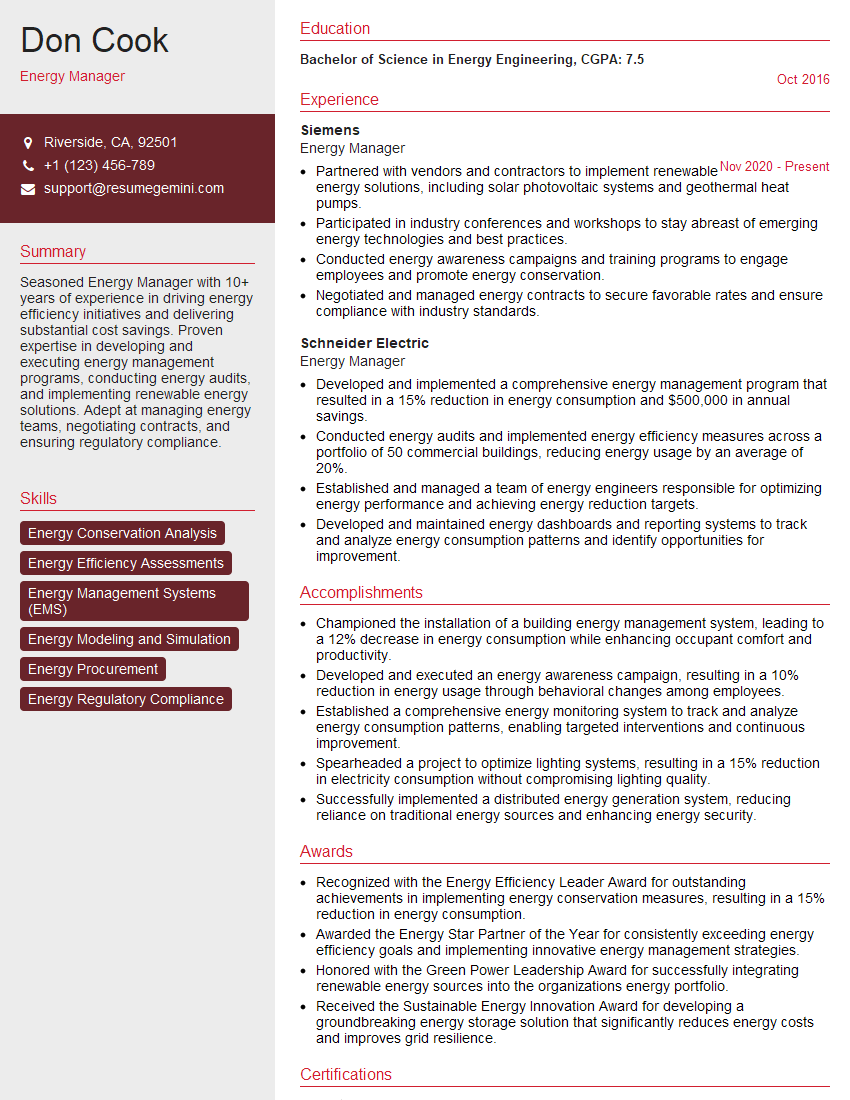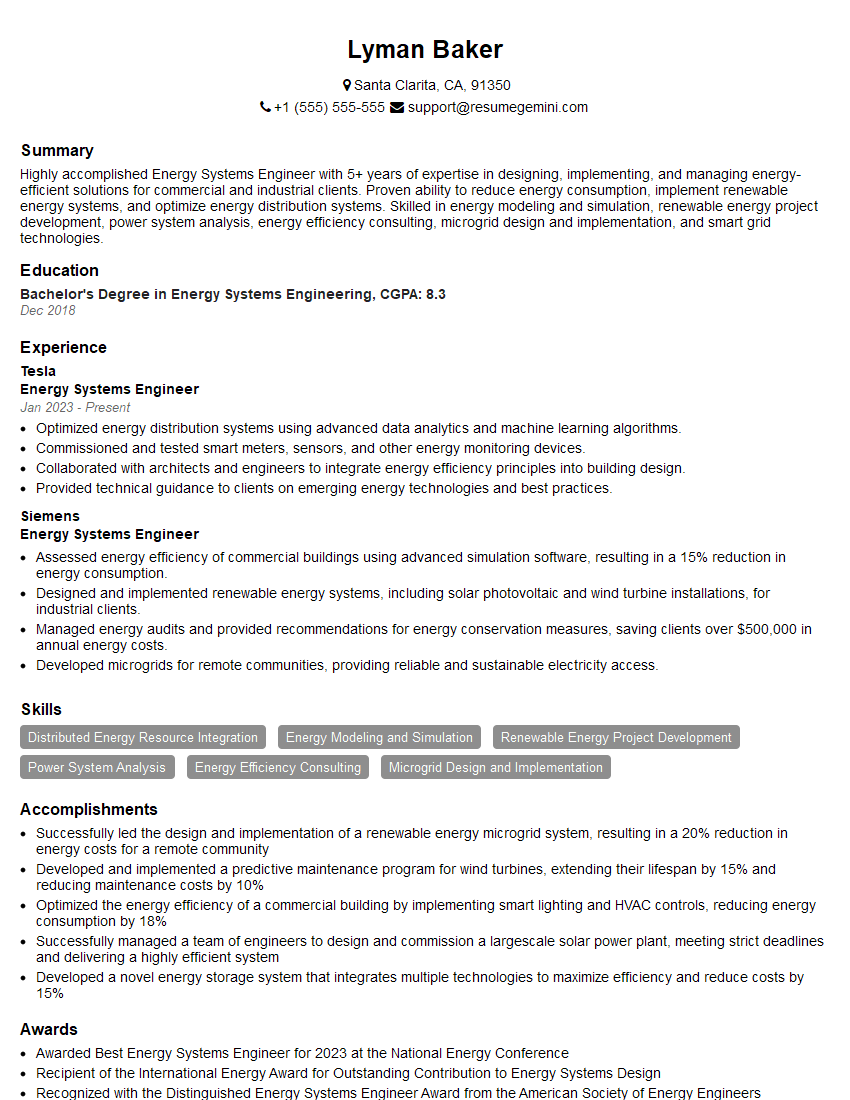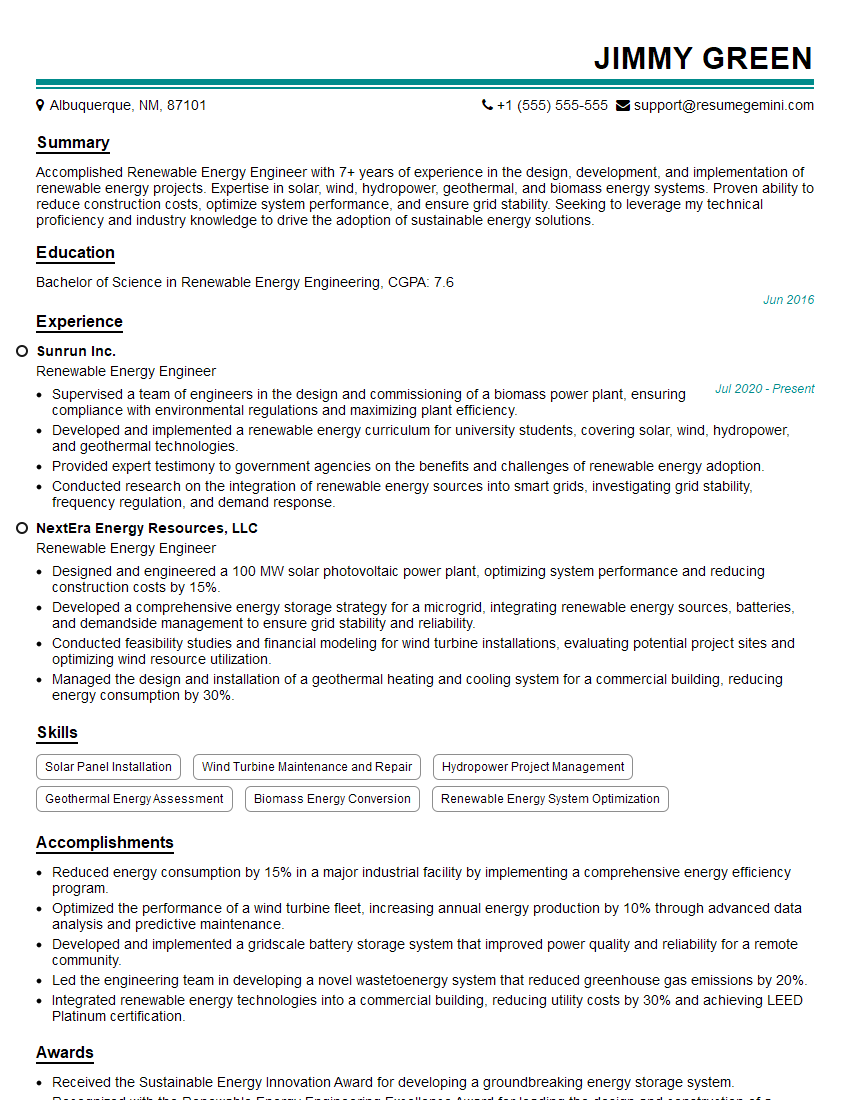Preparation is the key to success in any interview. In this post, we’ll explore crucial Energy Efficiency Technologies interview questions and equip you with strategies to craft impactful answers. Whether you’re a beginner or a pro, these tips will elevate your preparation.
Questions Asked in Energy Efficiency Technologies Interview
Q 1. Explain the concept of energy efficiency and its importance.
Energy efficiency is about using less energy to achieve the same level of service or output. Imagine driving a car – you can get from point A to point B using a gas-guzzling SUV or a fuel-efficient hybrid. Both get you there, but the hybrid requires significantly less energy (fuel). The importance of energy efficiency is multifaceted: it reduces operating costs, lowers greenhouse gas emissions (combatting climate change), enhances energy security by reducing reliance on external energy sources, and improves overall sustainability.
For example, a building retrofitted with energy-efficient windows and insulation can dramatically reduce its heating and cooling load, translating to lower energy bills and a smaller carbon footprint. Similarly, industrial processes optimized for energy efficiency can save millions of dollars annually while lessening their environmental impact.
Q 2. Describe different energy audit methodologies.
Energy audit methodologies vary, but they generally involve a systematic assessment of energy consumption patterns and identification of areas for improvement. Common approaches include:
- Walk-through audits: These are visual inspections of equipment and systems to identify obvious inefficiencies. They’re relatively inexpensive and quick but lack the depth of more comprehensive methods.
- Level I audits: These provide a basic assessment of energy consumption and potential savings, usually involving analysis of utility bills and site visits.
- Level II audits: These involve more detailed data collection, using energy monitoring equipment to pinpoint specific energy-consuming components. They offer a more precise understanding of energy use and potential for improvements.
- Level III audits: These are the most in-depth audits, incorporating detailed engineering analysis, simulations, and often specialized equipment to identify and quantify energy savings from complex system upgrades.
The choice of methodology depends on the building’s complexity, budget, and desired level of detail.
Q 3. What are the key performance indicators (KPIs) used to measure energy efficiency improvements?
Key Performance Indicators (KPIs) for measuring energy efficiency improvements are crucial for tracking progress and justifying investments. Common KPIs include:
- Energy consumption per square foot (or per unit of production): This normalizes energy use across different building sizes or production scales, enabling comparisons.
- Energy intensity: This represents the energy consumed per unit of output, reflecting efficiency gains in processes or systems.
- Return on investment (ROI): This assesses the financial return on energy efficiency investments, considering initial costs and long-term savings.
- Simple payback period: This indicates the time it takes for cumulative energy savings to offset the initial investment costs.
- Greenhouse gas emissions reduction: This measures the reduction in carbon footprint achieved through energy efficiency improvements, often expressed in tons of CO2 equivalent.
- Energy savings (kWh or therms): The absolute reduction in energy consumption achieved through implemented measures.
Q 4. How do you identify energy-saving opportunities in a building?
Identifying energy-saving opportunities in a building is a systematic process. It typically involves:
- Gathering data: Collect utility bills, building plans, and operational data to understand energy consumption patterns.
- Conducting a site survey: Visually inspect the building’s systems, looking for leaks, outdated equipment, and inefficient practices.
- Analyzing energy consumption: Use energy modeling software or manual calculations to identify the largest energy consumers (e.g., HVAC, lighting, plug loads).
- Identifying energy-saving measures: Based on the analysis, propose potential improvements such as upgrading lighting to LEDs, improving insulation, installing high-efficiency HVAC systems, or optimizing operational schedules.
- Cost-benefit analysis: Evaluate the cost and expected energy savings for each potential improvement to prioritize cost-effective measures.
For instance, a building with high energy consumption in lighting might benefit from a LED retrofit, while one with significant heat loss through the envelope could benefit from better insulation and window upgrades.
Q 5. Explain the principles of building envelope optimization for energy efficiency.
Building envelope optimization focuses on minimizing energy transfer between the building’s interior and exterior. The principles include:
- High-performance insulation: Using materials with high R-values (resistance to heat flow) in walls, roofs, and floors to reduce heat gain in summer and heat loss in winter.
- Air sealing: Minimizing air leakage through cracks and gaps in the building envelope to prevent unwanted air infiltration and exfiltration.
- High-performance windows: Installing windows with low U-values (heat transfer coefficient) and high solar heat gain coefficients (SHGC) to minimize heat loss and control solar heat gain.
- Properly designed shading devices: Using overhangs, awnings, or exterior shading systems to reduce solar heat gain during peak sun hours.
- Thermal bridging mitigation: Minimizing thermal bridging (paths of high thermal conductivity) through the building envelope to prevent heat transfer.
Optimizing the building envelope can significantly reduce heating and cooling loads, resulting in substantial energy savings and improved indoor comfort.
Q 6. Discuss various HVAC system energy efficiency technologies.
HVAC (Heating, Ventilation, and Air Conditioning) systems are major energy consumers in buildings. Energy-efficient technologies include:
- Variable Refrigerant Flow (VRF) systems: These systems provide precise temperature control to individual zones, reducing energy waste compared to traditional systems.
- Heat pumps: These highly efficient systems can both heat and cool a building by moving heat rather than generating it, significantly reducing energy consumption compared to conventional heating and cooling systems.
- High-efficiency air filters: Improving air filter efficiency reduces the load on the HVAC system and increases its lifespan.
- Demand-controlled ventilation: Adjusting ventilation rates based on occupancy and air quality needs minimizes energy use for ventilation.
- Building automation systems (BAS): These systems optimize HVAC operation based on real-time conditions, schedules, and occupancy data.
- Energy recovery ventilation (ERV) and heat recovery ventilators (HRV): These systems recapture heat or coolness from exhaust air to preheat or precool incoming fresh air.
Implementing these technologies can significantly reduce the energy consumption of HVAC systems.
Q 7. Describe your experience with energy modeling software (e.g., EnergyPlus, eQUEST).
I have extensive experience using EnergyPlus and eQUEST for energy modeling. EnergyPlus, a whole-building energy simulation program, is particularly useful for complex projects, allowing detailed modeling of building geometry, materials, systems, and operational strategies. I’ve utilized it to assess the energy performance of various building designs, from high-rise office buildings to residential complexes, optimizing designs to meet stringent energy efficiency targets. eQUEST, while simpler to use, provides a quicker way to analyze energy performance and helps conduct quick sensitivity analysis. I’ve used it for rapid assessments and preliminary design evaluations. In both cases, I’m proficient in inputting building data, running simulations, interpreting results, and generating reports to inform design decisions and identify optimal energy-saving strategies. For example, I used EnergyPlus to model the impact of different glazing types on the energy consumption of a proposed school building, ultimately leading to a design with significantly reduced heating and cooling loads.
Q 8. How do you analyze energy consumption data to identify areas for improvement?
Analyzing energy consumption data involves a systematic approach to pinpoint areas where energy is being wasted. It begins with data collection, often from smart meters, building management systems, or utility bills. This data is then processed to identify trends and anomalies. For example, unusually high energy usage during off-peak hours might indicate a malfunctioning piece of equipment.
Next, we use data analysis techniques, such as regression analysis or pattern recognition, to correlate energy consumption with factors like occupancy, weather conditions, and equipment operation. This helps us isolate the energy-intensive areas. Let’s say our analysis shows a strong correlation between increased HVAC energy consumption and periods of high occupancy in a specific wing of a building; this points towards potential inefficiencies in the HVAC system’s zoning or control strategies.
Finally, we prioritize areas for improvement based on the magnitude of the savings potential and the feasibility of implementing solutions. A simple fix offering significant savings would naturally be prioritized over a complex, expensive solution with only marginal benefits. Software tools like energy modeling software help to simulate and predict the impacts of different efficiency measures, helping us further refine our recommendations.
Q 9. Explain the role of building automation systems in energy efficiency.
Building automation systems (BAS) are the nervous system of a modern building, playing a crucial role in energy efficiency. They integrate various building systems – HVAC, lighting, security, etc. – under a central control system. This allows for real-time monitoring and automated control, optimizing energy use based on occupancy, weather, and other factors. For instance, a BAS can automatically dim or switch off lights in unoccupied areas, adjust thermostat setpoints based on occupancy schedules, and optimize HVAC airflow based on real-time temperature readings.
Think of it like a sophisticated thermostat on steroids! Instead of just controlling a single room, a BAS controls an entire building, making intelligent decisions to minimize energy waste. Furthermore, a well-designed BAS provides data for energy analysis, allowing for continuous improvement and proactive maintenance.
Some advanced BAS systems utilize machine learning to predict energy usage and optimize building performance even further. These systems learn from historical data and adapt their control strategies to minimize energy consumption while maintaining occupant comfort. This predictive capability is crucial for maximizing the energy-saving potential of a building.
Q 10. What are the benefits and drawbacks of different renewable energy sources?
Renewable energy sources offer a pathway towards a sustainable energy future, but each has its own set of benefits and drawbacks. Let’s consider solar, wind, and hydro power as examples.
- Solar Power: Benefits include abundant sunlight in many regions, decreasing costs, and minimal environmental impact during operation. Drawbacks include intermittency (sunlight is not always available), land use requirements for large-scale solar farms, and manufacturing processes with some environmental impacts.
- Wind Power: Benefits include high energy yields in windy areas and minimal land use compared to solar. Drawbacks include visual and noise pollution concerns, intermittency (wind is not always available), and potential impacts on birds and bats.
- Hydro Power: Benefits include high energy density and reliable power generation, while drawbacks include significant environmental impacts like habitat disruption and greenhouse gas emissions from decaying organic matter in reservoirs, plus geographical limitations to its use.
The ‘best’ renewable energy source depends heavily on location-specific factors and the energy demand profile. A comprehensive energy assessment considering various renewable sources and their integration with the existing grid is necessary for optimizing energy production and minimizing drawbacks.
Q 11. Describe your experience with commissioning and retro-commissioning projects.
Commissioning (Cx) and retro-commissioning (RCx) are crucial processes in ensuring that building systems operate efficiently and as intended. Cx is performed during the construction or renovation phase, verifying that all systems are properly installed and function according to the design specifications. RCx, on the other hand, is conducted on existing buildings to identify and correct operational inefficiencies.
In my experience, I’ve led several Cx and RCx projects across various building types, from office complexes to industrial facilities. This involved developing detailed commissioning plans, conducting functional performance tests, verifying compliance with energy codes, and developing recommendations for improvements. For example, in one RCx project, we identified a significant issue with improper HVAC zoning, leading to overcooling in certain areas and wasted energy. By re-zoning the system and implementing automated controls, we achieved a 15% reduction in HVAC energy consumption.
A successful Cx/RCx project requires a strong understanding of building systems, meticulous testing procedures, and effective communication among stakeholders. It’s more than just checking boxes; it’s about optimizing building performance throughout its life cycle.
Q 12. How do you evaluate the cost-effectiveness of energy efficiency projects?
Evaluating the cost-effectiveness of energy efficiency projects requires a comprehensive approach. We typically use a combination of metrics, including the simple payback period, return on investment (ROI), and net present value (NPV).
The simple payback period calculates how long it takes for the cumulative energy savings to equal the initial investment. For example, if an energy-efficient lighting upgrade costs $10,000 and results in annual savings of $2,000, the payback period is five years (10,000/2,000). ROI expresses the return on the investment as a percentage. In this case, the ROI would be 20% per year (2,000/10,000). NPV takes into account the time value of money and discounts future savings to their present value. NPV calculations are especially useful when evaluating long-term projects.
Beyond financial metrics, we also consider non-monetary benefits such as improved indoor environmental quality, increased comfort, and reduced greenhouse gas emissions. A robust cost-effectiveness analysis considers all relevant costs and benefits, helping decision-makers choose the most beneficial energy efficiency upgrades.
Q 13. Explain the concept of life-cycle cost analysis (LCCA).
Life-cycle cost analysis (LCCA) is a comprehensive method for evaluating the total cost of an asset or system over its entire lifespan. This includes all costs from initial investment to eventual disposal, taking into account operating costs, maintenance, repairs, and replacement. It’s crucial for making informed decisions about long-term investments like energy efficiency upgrades. For example, while a less-expensive piece of equipment might seem appealing initially, an LCCA might reveal higher long-term costs due to frequent maintenance or shorter lifespan.
LCCA uses discounted cash flow analysis to account for the time value of money. Future costs and benefits are discounted to their present value, providing a realistic picture of the overall financial implications. By considering all costs across the entire life cycle, LCCA helps identify the most cost-effective option that balances initial costs with long-term performance and sustainability.
An LCCA helps ensure a project’s long-term sustainability, considering factors like material durability, expected lifespan, and potential end-of-life costs.
Q 14. What are the key elements of a successful energy efficiency program?
A successful energy efficiency program requires a multi-faceted approach incorporating several key elements. It starts with a strong commitment from leadership and buy-in from all stakeholders. A comprehensive energy audit is crucial to establish a baseline and identify areas for improvement.
A well-defined plan is then needed, specifying goals, targets, and timelines, as well as the technologies and strategies to be implemented. Effective implementation involves not just technical changes but also engaging occupants to promote energy-conscious behavior. This can include training sessions, awareness campaigns, and feedback mechanisms.
Regular monitoring and evaluation are essential to track progress towards goals, identify potential challenges, and make adjustments to the program as needed. Data analysis helps to determine the effectiveness of implemented measures, suggesting further improvements. Finally, continuous improvement is crucial for ensuring long-term success. Regularly reviewing the program and adapting it to changing conditions will maximize its impact.
Q 15. How do you communicate complex technical information to non-technical audiences?
Communicating complex technical information to a non-technical audience requires a strategic approach that prioritizes clarity and simplicity. I achieve this by focusing on analogies, visual aids, and storytelling. Instead of using jargon, I explain concepts using everyday language and relatable examples. For instance, when discussing energy efficiency improvements in a building, I might compare the building’s energy consumption to a leaky bucket, illustrating how various measures, like insulation (reducing leaks) and efficient appliances (using less water), can dramatically reduce overall energy loss. I also use visuals like charts and diagrams to represent data effectively. This combination of plain language, relatable analogies, and visual aids helps ensure the audience grasps the core concepts without getting bogged down in technical details.
For example, when explaining the concept of thermal bridging in building insulation, instead of discussing complex heat transfer equations, I might use a simple visual of a bridge and explain how heat ‘flows’ through that conductive element, similar to how people cross a bridge. This makes the concept immediately understandable and memorable.
Career Expert Tips:
- Ace those interviews! Prepare effectively by reviewing the Top 50 Most Common Interview Questions on ResumeGemini.
- Navigate your job search with confidence! Explore a wide range of Career Tips on ResumeGemini. Learn about common challenges and recommendations to overcome them.
- Craft the perfect resume! Master the Art of Resume Writing with ResumeGemini’s guide. Showcase your unique qualifications and achievements effectively.
- Don’t miss out on holiday savings! Build your dream resume with ResumeGemini’s ATS optimized templates.
Q 16. Describe your experience working with energy efficiency incentives and rebates.
My experience with energy efficiency incentives and rebates is extensive. I’ve worked extensively with various governmental and utility programs, assisting clients in navigating the application processes, identifying eligible measures, and maximizing their financial benefits. This includes everything from federal tax credits for solar installations to local utility rebates for high-efficiency HVAC systems. I’m familiar with the intricacies of different program requirements, including documentation needs, eligibility criteria, and application deadlines. I understand how to analyze energy audits and project proposals to determine the most cost-effective and incentive-eligible upgrades. For example, I recently helped a small business secure a significant rebate for upgrading its lighting system to LED, resulting in significant cost savings and a reduced carbon footprint.
A key part of my role is staying current on all applicable regulations and program changes to ensure clients receive the maximum possible financial assistance. This requires ongoing research and networking within the energy efficiency sector.
Q 17. Explain your understanding of energy codes and standards (e.g., ASHRAE, IECC).
Energy codes and standards, such as those published by ASHRAE (American Society of Heating, Refrigerating and Air-Conditioning Engineers) and the IECC (International Energy Conservation Code), provide minimum requirements for energy efficiency in buildings and other applications. These codes dictate design and construction practices aimed at reducing energy consumption and improving overall building performance. I possess a thorough understanding of these codes and their implications for various project types. This includes requirements related to insulation, window performance, HVAC systems, lighting, and building envelope design. For example, ASHRAE 90.1 sets standards for energy efficiency in buildings, and I use this as a baseline when designing or evaluating building energy systems. Similarly, familiarity with the IECC allows me to ensure projects comply with local and national regulations. My work regularly involves interpreting and applying these codes to ensure compliance and maximize energy efficiency.
Understanding these codes is critical for successful project planning and execution, ensuring designs meet not only performance goals but also legal requirements.
Q 18. How do you manage energy efficiency projects within budget and timeline constraints?
Managing energy efficiency projects within budget and timeline constraints necessitates a structured approach. I begin with a detailed project scope, including clear objectives, deliverables, and a realistic timeline. This is followed by creating a detailed budget, incorporating all anticipated costs, including materials, labor, permits, and contingency funds. I use project management software to track progress, identify potential delays, and manage resources effectively. Regular monitoring and reporting are crucial to ensure the project stays on track. Should unexpected challenges arise, I develop and implement contingency plans to mitigate potential overruns or delays. Effective communication with stakeholders is also critical, ensuring everyone is informed of progress and any potential issues.
For example, on a recent large-scale lighting retrofit project, I proactively identified potential supply chain delays and secured alternate suppliers, preventing a significant project delay. This proactive approach saved time and money, demonstrating my ability to manage risk effectively.
Q 19. Describe your experience with energy conservation measures (ECMs).
Energy Conservation Measures (ECMs) are specific actions taken to reduce energy consumption. My experience encompasses a wide range of ECMs, including building envelope improvements (insulation, air sealing), high-efficiency HVAC systems (heat pumps, variable refrigerant flow systems), efficient lighting (LED retrofits, daylight harvesting), and optimized building controls (smart thermostats, occupancy sensors). I assess the suitability of each ECM based on factors like cost-effectiveness, energy savings potential, and project feasibility. A thorough energy audit is crucial in identifying the most impactful ECMs for a specific building or facility. For instance, I’ve successfully implemented ECMs that have resulted in a 30% reduction in energy consumption for several commercial buildings, leading to significant cost savings for the building owners.
The selection of ECMs is not a one-size-fits-all approach; it requires careful consideration of the specific characteristics of each building and its operational profile. This often involves considering the life cycle cost analysis of each measure to determine long-term return on investment.
Q 20. What is your understanding of demand-side management (DSM)?
Demand-side management (DSM) is a strategic approach to managing electricity demand by influencing how and when electricity is used. It’s not about generating more power, but rather about optimizing electricity consumption. DSM programs often involve a mix of incentives, technical upgrades, and behavioral changes to reduce peak demand and shift energy use to off-peak hours. This helps reduce the need for expensive peaking power plants and improves grid stability. My understanding of DSM encompasses various strategies, including time-of-use pricing, energy efficiency programs, and demand response initiatives. I’ve worked on projects that involved implementing time-of-use rates for industrial clients, leading to a significant reduction in their peak demand charges. This resulted in substantial cost savings and improved their overall energy management efficiency.
DSM is crucial for building a sustainable and resilient energy future by reducing stress on the power grid and promoting efficient electricity use.
Q 21. How do you approach the problem of energy waste in industrial settings?
Addressing energy waste in industrial settings requires a systematic approach that involves a combination of energy audits, process optimization, and technological upgrades. I start by conducting a thorough energy audit to identify the major energy-consuming processes and equipment. This includes analyzing energy usage patterns, identifying inefficiencies, and assessing the potential for improvements. Following the audit, I develop customized strategies to reduce energy consumption, focusing on areas like compressed air systems, process heating, and motor drives. This might involve replacing inefficient equipment with high-efficiency alternatives, implementing energy management systems, or optimizing operational processes. For example, I helped an industrial facility reduce its compressed air system energy consumption by 25% through a combination of leak detection and repair, improved system controls, and the replacement of outdated compressors.
In industrial settings, energy waste often manifests in subtle ways, so thorough investigation and data analysis are vital for uncovering significant opportunities for improvement.
Q 22. Explain your experience with energy data acquisition and monitoring systems.
My experience with energy data acquisition and monitoring systems spans over a decade, encompassing diverse projects ranging from small commercial buildings to large industrial complexes. I’ve worked extensively with various systems, from basic building management systems (BMS) to sophisticated IoT-based platforms. This involves not only the installation and configuration of sensors (measuring electricity, gas, water consumption, temperature, humidity etc.), but also the crucial aspects of data analysis and interpretation.
For example, in one project, we implemented a system using smart meters and a cloud-based platform to monitor energy consumption in a multi-tenant office building. This allowed us to identify energy waste in individual units, leading to targeted energy efficiency improvements. Another project involved the integration of a BMS with advanced analytics tools to predict equipment failures and optimize energy usage in a manufacturing facility, preventing costly downtime and reducing energy waste significantly.
My expertise also includes working with various communication protocols (e.g., Modbus, BACnet, SNMP) to integrate data from different sources into a unified platform, enabling comprehensive energy performance analysis and reporting. This involves understanding the limitations and capabilities of different sensor types and selecting appropriate solutions for different applications.
Q 23. What are the challenges of implementing energy efficiency measures in existing buildings?
Implementing energy efficiency measures in existing buildings presents a unique set of challenges. Often, the biggest hurdle is the need to retrofit existing infrastructure, which can be costly and disruptive. For example, installing new insulation in a building with limited access to walls or ceilings can be difficult and labor-intensive.
Another challenge lies in balancing the cost of improvements with the potential energy savings. A thorough energy audit is crucial to identify the most cost-effective solutions, ensuring that the return on investment justifies the expenditure. It’s also important to consider the building’s occupancy and use patterns. Modifications needed for a school will differ significantly from those for a hospital or a commercial office.
Furthermore, achieving buy-in from building occupants is critical. Changes to lighting, heating, or ventilation systems can impact comfort and productivity, so it’s essential to communicate clearly the benefits of the changes and address any concerns. Regulatory compliance and the need for specialized contractors further complicate the process. The process often necessitates careful planning, coordinating with stakeholders, and meticulous project management.
Q 24. Describe your knowledge of different types of insulation materials and their application.
Insulation materials play a crucial role in energy efficiency, reducing heat transfer and improving thermal comfort. Different materials offer various properties, suitability for different applications, and environmental impacts.
- Fiberglass: A common and cost-effective option, it’s widely used in walls, attics, and ceilings. It’s lightweight and easy to install but can irritate skin during installation.
- Cellulose: Made from recycled paper, it’s a sustainable and effective insulator. It has excellent thermal properties and sound dampening capabilities but requires specialized installation techniques.
- Mineral Wool: Including rock wool and slag wool, these are durable, fire-resistant, and good sound insulators. They can be more expensive than fiberglass but have excellent long-term performance.
- Spray Foam: Offers excellent air sealing and thermal performance, filling gaps and cracks effectively. It’s durable and long-lasting, but it requires specialized equipment and trained installers.
- Polyurethane and Polyisocyanurate: These rigid foam boards are used for exterior wall insulation and roofing, providing high R-values (a measure of thermal resistance). They are strong and durable but can be sensitive to moisture.
The choice of insulation material depends on factors like budget, building characteristics, climate, and environmental considerations. For example, in a historical building, the choice might be limited due to preservation requirements, potentially impacting the achievable energy efficiency levels.
Q 25. How do you ensure compliance with environmental regulations related to energy efficiency?
Ensuring compliance with environmental regulations related to energy efficiency involves a multi-faceted approach. It starts with a thorough understanding of the relevant regulations – which vary widely by location and building type – including codes, standards, and incentives. These could include ASHRAE standards, local building codes, and national energy efficiency targets.
This understanding informs the design and implementation of energy efficiency projects. For instance, when designing a new building, compliance requirements dictate aspects like insulation levels, window specifications, and HVAC system efficiency. For retrofits, compliance involves obtaining necessary permits, documenting the improvements, and undergoing inspections to verify compliance.
Furthermore, accurate documentation of energy performance, often required as part of the compliance process, is essential. Data from energy monitoring systems is often used to demonstrate compliance, often involving the submission of energy audits and compliance reports to the relevant authorities. Staying abreast of evolving regulations through continuous professional development is also crucial to maintaining compliance and best practices. Failure to meet these requirements can lead to hefty fines, project delays, and legal repercussions.
Q 26. Explain your experience with LEED certification or other green building rating systems.
I have extensive experience with LEED (Leadership in Energy and Environmental Design) certification and other green building rating systems, including BREEAM and Green Globes. My involvement has ranged from pre-design consultation and documentation to post-construction verification.
In several projects, I’ve led teams in implementing strategies to achieve LEED points, focusing on energy efficiency, water conservation, sustainable materials, and indoor environmental quality. This involves meticulous documentation, energy modeling, and close collaboration with architects, engineers, and contractors.
For instance, I helped a large office building achieve LEED Gold certification by optimizing the HVAC system, implementing high-performance glazing, and utilizing recycled building materials. Understanding the specific requirements and weighting of points for each rating system is critical to maximizing the chances of successful certification and delivering a truly sustainable building. This includes a deep understanding of embodied carbon calculations and life-cycle assessments. The successful certification process frequently results in enhanced property value and improved building performance.
Q 27. What are some emerging technologies in the field of energy efficiency?
The field of energy efficiency is constantly evolving, with several emerging technologies promising significant advancements.
- Smart Building Technologies: Artificial intelligence (AI) and machine learning (ML) are revolutionizing building management by enabling predictive maintenance, optimized energy scheduling, and real-time energy consumption control. This also includes the use of building information modelling (BIM) which allows for more efficient design and construction.
- Building-Integrated Photovoltaics (BIPV): Integrating solar panels directly into building materials (like roofing tiles or facades) provides an aesthetically pleasing and efficient way to generate renewable energy on-site.
- Smart Grid Technologies: These allow for better management of electricity distribution and consumption, enabling more efficient use of renewable energy sources and reducing peak demand.
- Advanced HVAC Systems: Heat pumps with improved efficiency and variable refrigerant flow (VRF) systems offer better climate control with lower energy consumption.
- Energy Storage: Battery technology advancements allow for efficient storage of renewable energy, addressing intermittency issues and increasing grid stability.
These technologies, when implemented thoughtfully, have the potential to significantly improve energy efficiency, reduce operational costs, and minimize the environmental impact of buildings and industrial processes. This requires a careful evaluation of cost-effectiveness, lifespan, and maintenance considerations.
Key Topics to Learn for Energy Efficiency Technologies Interview
- Building Envelope Optimization: Understanding insulation materials, window technologies, air sealing techniques, and their impact on energy consumption. Practical application: Analyzing building blueprints to identify areas for energy efficiency improvements.
- HVAC Systems and Controls: Knowledge of different HVAC system types (e.g., heat pumps, chillers), their efficiency ratings (SEER, EER), and smart control systems. Practical application: Troubleshooting inefficient HVAC systems and proposing cost-effective solutions.
- Renewable Energy Integration: Familiarity with solar photovoltaic (PV) systems, wind turbines, and geothermal energy, including their integration with existing energy grids. Practical application: Designing a renewable energy system for a residential or commercial building.
- Lighting Technologies: Understanding different lighting technologies (LED, CFL, incandescent) and their energy efficiency characteristics. Practical application: Conducting lighting audits and recommending energy-efficient replacements.
- Energy Auditing and Modeling: Proficiency in using energy modeling software and conducting energy audits to identify energy waste and improvement opportunities. Practical application: Creating energy efficiency improvement plans based on audit results.
- Energy Management Systems (EMS): Understanding the principles of building automation systems and their role in optimizing energy consumption. Practical application: Programming and configuring EMS to enhance energy efficiency.
- Policy and Regulations: Familiarity with relevant energy efficiency standards, codes, and incentives. Practical application: Advising clients on available rebates and incentives for energy efficiency upgrades.
Next Steps
Mastering Energy Efficiency Technologies opens doors to a rewarding career with significant growth potential in a rapidly expanding field. The demand for skilled professionals in this sector is high, making it a crucial time to invest in your expertise. To maximize your job prospects, creating a strong, ATS-friendly resume is essential. ResumeGemini can help you build a professional resume that highlights your skills and experience effectively. They offer examples of resumes tailored specifically to Energy Efficiency Technologies, providing you with valuable templates and guidance.
Explore more articles
Users Rating of Our Blogs
Share Your Experience
We value your feedback! Please rate our content and share your thoughts (optional).
What Readers Say About Our Blog
good

